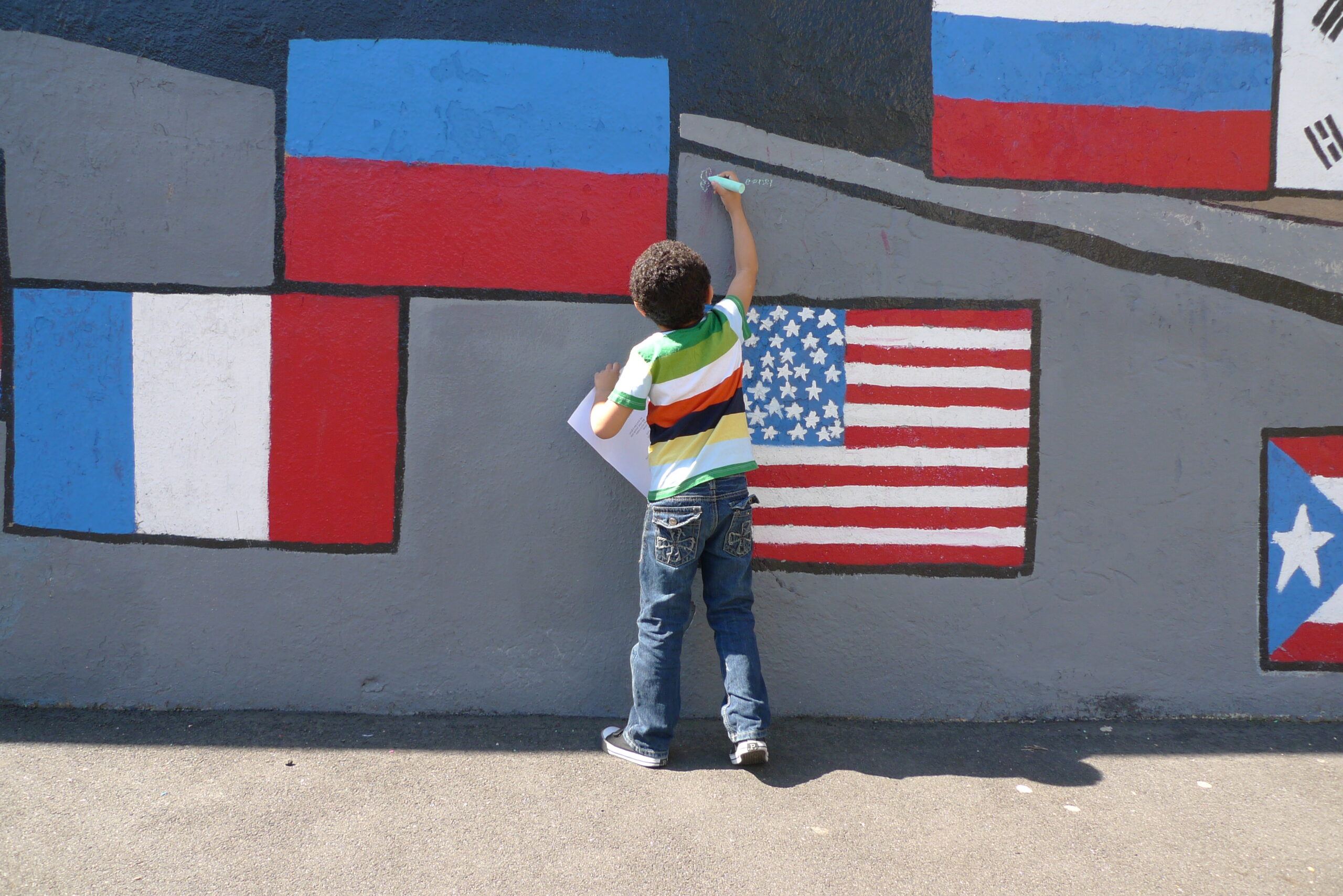This lesson is part of Writing Our Way Through: clear, fun, and engaging “lessons” for writing at home with young people.
Author/Teaching Artist: by Matthew Burgess
Age Range: Kindergarten through 4th Grade (Can be adapted for older children by adding greater freedom or complexity—see below.)
Materials: Paper, pencils/pens, Louis Armstrong’s “What a Wonderful World”
Overview
This straightforward lesson is a good follow-up to “Delight Songs” since it gives participants an opportunity to further explore descriptive language ( “delicious details”) that we introduced in “Delight Songs.” One way to enhance detail in our writing is to engage the senses, and this exercise helps to reinforce these ideas in a playful way.
The Steps
1. Find “What a Wonderful World” on your music streaming site of choice (or use the YouTube link above, which includes lyrics). You might briefly share a photo or image of Louis Armstrong and explain that he was one of the greatest jazz musicians of all time. He was born and raised in New Orleans, Louisiana, and his nicknames were “Satchmo,” “Satch,” and “Pops.”
2. Once everyone is assembled and settled, play the song. Participants can silently read the lyrics as they listen, or they can sing along.
3. When the song is over, ask participants if they noticed how Armstrong uses his senses to describe the world around him. What does he see? What does he hear? The lyrics are rather spare in terms of description, but you can point out that even small details make a difference. For example, in the first stanza, you might highlight the use of colors (“trees of green”), a specific type of flower “red roses”), and also the verb “bloom.”
4. With younger writers, I like to brainstorm the five senses on the board or sheet of paper. If someone offers “seeing,” you can write it down as “I see…” and skip a line, so that you end up with something like:
I see…
I hear…
I touch…
I taste…
I smell…
5. Now you might float some questions: What kinds of details would your wonderful world include? If you can imagine a world, a setting, or “scene” that includes things that you really enjoy, what would it look, sound, and feel like?
6. Now it’s time for a little meditation. The leader of this activity invites participants to close their eyes (or just relax, if the invitation to close eyes meets resistance), and then you lead them in a brief visualization. (Don’t be shy about this; it’s easier than you might think.) After a couple collective deep breaths, gently ask some version of the following questions in an unrushed way, with pauses in between. Feel free to abbreviate it or make it your own so that it feels natural to you.
Begin to imagine a world, or a place, where you feel calm, happy, or peaceful. With your eyes closed, take a moment to envision this environment. What do you see in your mind’s eye when you look around? Who or what might be there with you? What can you hear in this place? Is there music playing, or the voice of someone you love, or the sound of the breeze or the ocean? What can you feel or touch in this place? Maybe it’s the sun on your skin, or the soft fur of a favorite pet? Take a moment and just notice. Is there something nice that you can smell in this place, whether it’s food being cooked or baked, or the perfume of someone you love? Finally, what might you taste in this place? What kinds of food or drink would you enjoy here? Can you taste something tart, or sweet, or spicy?
7. Conclude the meditation by inviting everyone to open their eyes. Now, without talking about it too much (you don’t want those details to drift away in conversation, the way a dream can begin to vanish upon waking ), ask all the participants to describe their “wonderful worlds” using the five senses. With very young ones, you might make simple worksheets beforehand by writing the prompts and leaving spaces for them to fill in.
8. Now everyone writes quietly together for approximately 5-7 minutes. The temporary title is “In my wonderful world,” and the participants should try to write at least one descriptive detail for each sense. For an additional challenge at the end, you might complete the sentence, “And I think to myself……” by adding your own twist.
If you are writing with children for whom this template feels limiting, you can open it up and give more freedom. Instead of describing your “worlds” in a sense-by-sense list, you can write a spontaneous paragraph in prose (or as a “prose poem”) that describes this place in vivid detail.
Along these lines, if participants want to take this is a more playful or absurdist direction, set them free. Just because Armstrong’s song is lovely and lyrical doesn’t mean the poems written in response need to be, and we don’t want to give young people the impression that poetry should be “flowers and butterflies” all the time. The student model poems below demonstrate that students can take this in very different directions, and that dance of originality should be encouraged.
9. Invite participants to share all or part of their poems aloud.
10. These poems are especially well suited to a drawing activity. Once the writing is over, you might have some art supplies on hand for participants to draw or paint a scene from their poems. During this drawing component, you can play Armstrong’s song again. If you have Spotify, you can try this playlist of similarly meditative, uplifting songs.
Literary Terms, Forms, and Devices: Delicious details, “list poems.”
Acknowledgments / References: “What a Wonderful World,” performed by Louis Armstrong, was written by Bob Theile and George Weiss.

Mentor Text
What a Wonderful World
I see trees of green, red roses too
I see them bloom for me and you
And I think to myself, what a wonderful world
I see skies of blue and clouds of white
The bright blessed day, the dark sacred night
And I think to myself, what a wonderful world
The colors of the rainbow, so pretty in the sky
Are also on the faces of people going by
I see friends shaking hands, saying, “How do you do?”
They’re really saying, “I love you.”
I hear babies crying, I watch them grow
They’ll learn much more than I’ll ever know
And I think to myself, what a wonderful world
Yes I think to myself, what a wonderful world
Oh…. Yeah….
Student Poems
In My Wonderful World
I see a chameleon beating up a lion in 100 pieces.
–Kuntal H., Grade 2
I hear a saber-toothed tiger roaring for happiness.
I taste vanilla ice cream with rainbow sprinkles.
I touch a tiger’s skin that’s nice.
I smell ice cream in my house.
And I think to myself
that I am a paleontologist for dinosaurs.
In My Wonderful World
I see my own candy world with licorice canoes and chocolate streams.
–Ahmed M., Grade 1
I hear candy birds just giving birth to little chocolate eggs
the Easter bunny steals and gives us
creamy white cookie-and-cream eggs waiting for us.
I taste the chocolate streams, so good, like it fell from heaven and paradise.
I touch licorice so thick and fat, red as roses,
and roses come out of the red tasty licorice.
I smell from a mile away, lovely little chocolates
like they come from angels and angels gave them to us.
And I think to myself, what a colliding,
illusionary world of many things.
My world, my life.
In My Wonderful World
I see a kitten named Mr. Wield.
–Angela V, Grade 2
I was in a forest with Mr. Wield.
I sat down on a seat and so did Mr. Wield
And we drank tea and ate hot dogs.
When we were done, Mr. Wield
opened a door to his world
and invited me to come in and I did.
I jumped and ran. They had everything!
Everything in the world was kittens:
Kitten bread, kitten ketchup, and
kitten hot dogs. I went to a kitten store.
There was human food that had
kitten faces on it. I saw a present wrapper
that also had kitten faces on it.
I took one of everything.
Matthew Burgess is an Associate Professor at Brooklyn College. He is the author of eight children's books, most recently The Red Tin Box (Chronicle) and Sylvester’s Letter (ELB). Matthew has edited an anthology of visual art and writing titled Dream Closet: Meditations on Childhood Space (Secretary Press), as well as a collection of essays titled Spellbound: The Art of Teaching Poetry(T&W). More books are forthcoming, including: As Edward Imagined: A Story of Edward Gorey (Knopf, 2024), Words With Wings & Magic Things (Tundra, 2025), and Fireworks (Harper Collins, 2024). A poet-in-residence in New York City public schools since 2001, Matthew serves as a contributing editor of Teachers & Writers Magazine.




